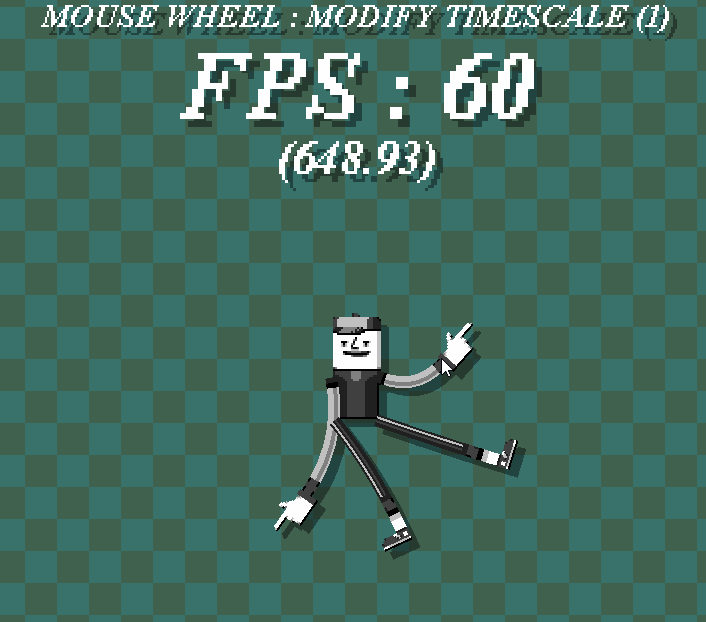This demo utilizes quadratic bezier curve and (slightly modified) Verlet integration to simulate and render a silly-looking, Procedurally animated humanoid figure.
The core principle is to simulate the physics of a 3 linked particles as a "limb" via integrators such as verlet integration or euler method, And using those 3 particles as control points for Quadratic Bézier curve.
The principle would be pretty much the same even if you use different methods like RK4 or (velocity) Verlet and Euler method.
Note : The way I'm integrating is unstable on high delta time / time scale, Using other stable methods are recommended, If accurate simulation of particles are required.
Following function calculates / evaluates quadratic bezier curve and returns the position :
/// zb_quadratic_get(p1, p2, p3, t)
/*
Evaluates quadratic bezier curve from given points (p1, p2, p3) at given moment (t)
returns 2D-position in array
*/
var _p1 = argument0, _p2 = argument1, _p3 = argument2, _t = argument3;
// calculate coefficients & pre-multiply
// OG formula : (1 - t) * (1 - t) * p1 + 2 * (1 - t) * t * p2 + t * t * p3
// by making a few variables that stores frequently used coefficients (like (1 - t) and t * t) we can simplify the formula
var _tsqr = _t * _t;
var _invt = 1.0 - _t;
var _invtsqr = _invt * _invt;
_invt *= _t * 2;
// use the coefficients to calculate / interpolate the quadratic bezier curve's control points
var _x = _invtsqr * _p1[@ 0] + _invt * _p2[@ 0] + _tsqr * _p3[@ 0];
var _y = _invtsqr * _p1[@ 1] + _invt * _p2[@ 1] + _tsqr * _p3[@ 1];
// array_pack() is a function that returns an array that contains the given arguments for its elements
return array_pack(_x, _y);
Following function returns the derivative of quadratic bezier curve and returns the resulting tangent :
/// zb_quadratic_get_deriv(p1, p2, p3, t)
/*
Evaluates quadratic bezier curve's derivative from given points (p1, p2, p3) at given moment (t) &
returns 2D-tangent in array
Source formula from : https://en.wikipedia.org/wiki/B%C3%A9zier_curve
*/
// OG formula : 2 * (1 - t) * (p2 - p1) + 2 * t * (p3 - p2)
var _p1 = argument0, _p2 = argument1, _p3 = argument2, _t = argument3;
var _invt = (1.0 - _t) * 2.0;
_t *= 2.0;
var _x = _invt * (_p2[@ 0] - _p1[@ 0]) + _t * (_p3[@ 0] - _p2[@ 0]);
var _y = _invt * (_p2[@ 1] - _p1[@ 1]) + _t * (_p3[@ 1] - _p2[@ 1]);
return array_pack(_x, _y);
Following routine is used to update the verlet integrator system :
/// Update all
// calculate delta time
var _secperstep = 1.0 / room_speed; // Desired : 1 / 60 seconds for each frame
var _step = min(((delta_time * 0.000001) / _secperstep), 4.0) * timeScale; // Quick fix : cap the delta time to prevent the simulation jerking out
var _steppow = _step * _step;
// integrate particles
for (var i=0; i<ds_list_size(verlets); i++)
{
var _data = verlets[| i];
var _posprev = _data[@ eVERLET.POS_PREV];
var _pos = _data[@ eVERLET.POS];
var _acc = _data[@ eVERLET.ACCEL];
var _posx = _pos[@ 0];
var _posy = _pos[@ 1];
var _velx = (_posx - _posprev[@ 0]);
var _vely = (_posy - _posprev[@ 1]);
// Update previous position & accumulate velocities to current position
_posprev[@ 0] = _posx;
_posprev[@ 1] = _posy;
_pos[@ 0] += _velx + _acc[@ 0] * _steppow;
_pos[@ 1] += _vely + _acc[@ 1] * _steppow;
_acc[@ 0] = 0;
_acc[@ 1] = velGravity;
}
// update constraints
for (var k=0; k<linkIterations; k++)
{
for (var i=0; i<ds_list_size(links); i++)
{
var _data = links[| i];
// fetch both particles
var _p1 = verlets[| _data[@ eLINK.P1]], _p2 = verlets[| _data[@ eLINK.P2]];
var _p1pos = _p1[@ eVERLET.POS], _p2pos = _p2[@ eVERLET.POS];
// calculate distance between both particle and use that to make two particle "closer" to each other
// and apply appropirate force
var _linkdist = _data[@ eLINK.DIST];
var _pointdistx = _p1pos[@ 0] - _p2pos[@ 0], _pointdisty = _p1pos[@ 1] - _p2pos[@ 1];
var _pointdist = sqrt(_pointdistx * _pointdistx + _pointdisty * _pointdisty);
if (_pointdist > 0)
{
var _distdelta = (_linkdist - _pointdist) / _pointdist;
var _movefactorx = _pointdistx * _distdelta * velLinkTensionFactor, _movefactory = _pointdisty * _distdelta * velLinkTensionFactor;
_p1pos[@ 0] += _movefactorx; _p1pos[@ 1] += _movefactory;
_p2pos[@ 0] -= _movefactorx; _p2pos[@ 1] -= _movefactory;
}
}
}
After simulating / integrating the particles, We can use those results as control points that is used to draw the bezier curve.
/// ARM R bezier limb
// zv_get_pos() returns the position of verlet particle of given index.
// in this case, we're fetching the positions of 3 particles that forms the right arm limb.
var _rarmpos1 = zv_get_pos(armRightRoot), _rarmpos2 = zv_get_pos(armRightJoint), _rarmpos3 = zv_get_pos(armRightLeaf);
// here, zb_batch_quadratic_spr_alt() draws deformed sprite along the Quadratic Bezier curve's surface
// with first 3 arguments defines the 3 control points of Quadratic bezier curve.
zb_batch_quadratic_spr_alt(_rarmpos1, _rarmpos2, _rarmpos3, sprLimb, 0, 6 * _modelscale, 8, false);
Verlet integration :
Wikipedia : Verlet integration
Simulate Tearable Cloth and Ragdolls With Simple Verlet Integration
Bézier curve :
A Primer on Bézier Curves
Wikipedia : Bézier curve
A thread on Stack Exchange about getting the derivatives of Quadratic Bézier curve that helped me to understand what kind of cryptic language the formula used for curve is
